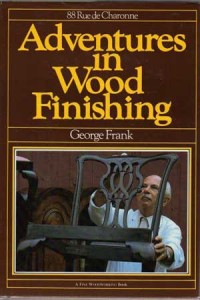 I was reorganizing some paperwork the other day, when I ran across a file that contained letters, manuscripts and notes from master wood finisher George Frank. I worked with George when I was an editor at Fine Woodworking magazine. I was originally assigned to work with George because he and I were both Hungarians and so could converse in our native tongue. Over the years, George became not only a treasured colleague of mine, but I also kind of became his adoped grandson; he had no male children of his own. George passed away nearly 15 years ago, at the ripe old age of 94.
I was reorganizing some paperwork the other day, when I ran across a file that contained letters, manuscripts and notes from master wood finisher George Frank. I worked with George when I was an editor at Fine Woodworking magazine. I was originally assigned to work with George because he and I were both Hungarians and so could converse in our native tongue. Over the years, George became not only a treasured colleague of mine, but I also kind of became his adoped grandson; he had no male children of his own. George passed away nearly 15 years ago, at the ripe old age of 94.
Now, if you don’t know who George Frank is, I strongly suggest you pick up a copy of his classic book: Adventures in Wood Finishing, published back in the 80s by the Taunton Press. That book will certainly not teach you everything there is to know about finishing wood. But just as certainly, you’ll be greatly entertained by George’s tales from his remarkable career starting back in the 1920s in Paris, France. He recounts stories (that some may call tall tales), like the time he was an apprentice finisher and his firm had been hired to stain and varnish the cabinetry in a bank. Due to a mix-up, the color of the stain ended up a couple of shades lighter than was desired, and the bank was supposed to reopen just a day later. So, the young apprentice approached the boss and said, “I know how to fix this.” He had his workmen brew up strong batches of ammonia, which were left heating in pots inside the sealed bank. Hours later, the fumes had penetrated the finish on the cabinetry and reacted with the tannins in the wood, thus darkening it to the desired degree and saving the job! Some years later, the accomplished Mr. Frank opened his own “Atelier” shop at 88 Rue de Charonne in Paris and, over the following decades, performed commissions for some very famous clients, including celebrities, millionaires and even a prince.
As I read through the correspondence in my “George Frank” file, many of the stories he wrote for his books and magazine articles came flooding back to me (including a few that were a little too bawdy for general publication, like how the art of wood finishing began in a French bordello). I was also reminded of some of the stories he told me in person, during my many visits to his home and shop in Naples, Florida. By far the most colorful story he told was about the time he had worked as a restorer for the Louvre Museum. George told me how he had discovered that many famous paintings on display in the museum were actually expert copies, and that the real paintings (too valuable to hang within the public’s reach) were stored in special vaults beneath the museum. After months of planning, George was able to “sneak out” a couple of these real paintings — including none other than DaVinci’s Mona Lisa! He did finally give the Mona Lisa back. But instead of going to jail for stealing it, George claimed he managed to get a commendation for recovering it! Whether or not you believe this tale, or some of George’s other fantastic adventures, they’ll always remain as entertaining legacies of an extraordinary man.
Sandor Nagyszalanczy





